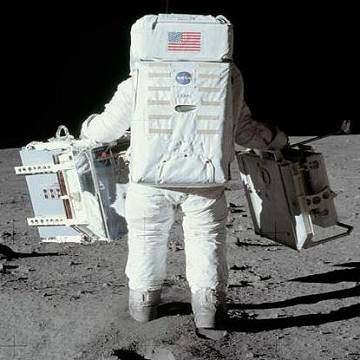
 https://www.hq.nasa.gov/alsj/ALSJ-FlightPLSS.pdf
https://www.hq.nasa.gov/alsj/ALSJ-FlightPLSS.pdfSo far. Life Support mainly cools the astronaut and supplies oxygen. Central part is the sublimator, a porous piece of metal that is fed with water from a reservoir. Piece of metal is "cooled by sublimation" of water from pores in vacuum to which is exposed.
Both gas for breathing and water for cooling the astronaut go through that plate and cool. Coolant temperature is regulated with a engine like thermostat and diversion of the flow.
PLSS itself needs to be cooled. Gas flowing around the astronaut also flows around the components of the PLSS, which is under the same pressure.
«This “gas cooled” PLSS used ventilation gas that circulated around the astronaut’s body and through the PLSS for cooling the astronaut and removing heat generated by the PLSS.»
The sublimator's vent only need to be exposed to outside vacuum. Can't understand from next picture how this is done since i don't see any seals between cover and sublimator and probably the other half of the cover that is missing from the next picture.
Cooling water is absorbed at the outer area of the sublimator by moon's vacuum and inside the reservoir by gravity and vacuum. However there is no thermal regulation (thermostat) for how much cooling water gets through it. Since liquid coolant temperature is regulated through diversion thus varying flow inside the sublimator which is not thermally regulated, it is very possible for it to freeze at low flow.


Water needs to boil inside the sublimator's pores in order to cool anything.
I anticipate water vapor coming out of the millions of tiny pores in the sublimator's plate and through that vent as gas at the speed of sound would make a terrible hissing that was going to be audible in the suit through the umbilical chords, and also blow that cover off.

On this image found on a different side it is shown the vent of the sublimator, though at the other side or "inside" of the "back pack", next to astronaut's suite.
More about NASA's sublimator from PLSS. The way they say it should work. First, water gets through the pores as sucked by the vacuum outside. Then it turns into ice and ice turns into vapor (otherwise they wouldn't call it a sublimator). And it all should happen at the surface of the plate that is exposed to vacuum. Otherwise freezing water inside the pores would damage it and/or water vapor from sublimation would come outside again at the speed of sound.
However freezing is an exothermic process. By freezing, water needs to loose heat in the environment. That wouldn't help with the cooling of the plate.
Of course sublimation loose more heat than boiling. However, in this case, you have to add that heat to the water in order to freeze it first. So nothing is lost, nothing is gained in the end compared to if evaporation would have occurred directly, without freezing first.
Then if sublimation occurs at the surface of the ice the porous plate won't loose much heat cause ice is a thermal insulator (frost cover coils inside freezers, before frost fee freezers, remember).
Also if freezing occur at the surface or even inside the pores, how more water is going to circulate through the sublimator anymore?
All it remains is water needs to evaporate inside the pores in order to absorb heat. But then it would blow away through the pores at the speed of sound as any gas released in vacuum. And you couldn't call it a sublimator anymore. You would call it a rocket engine.
Powder LiOH canister wich removes the CO2 by forming Li2CO3 has a limited capacity which decreases with the amount of CO2 stored. All oxygen supplied to the astronaut "enriches" with carbon from astronauts excretion through breathing and the amount of CO2 in the end should be heavier and bulkier than the O2 in the cylinder though much water comes out of the reaction.
Even if you have enough LiOH in the canister, corresponding to using the whole amount of oxygen, after let's say half or the LiOH being combined with CO2 the absorption capacity through reaction should diminish.
CO2 (g) + 2LiOH (s) -> Li2CO3 (s) + 3 H2O (l)


No comments:
Post a Comment
Friendly comments welcome
Note: Only a member of this blog may post a comment.